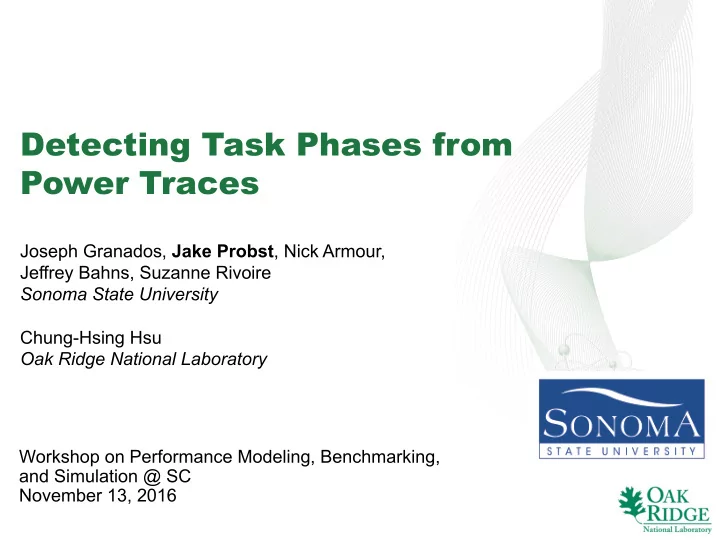

Detecting Task Phases from Power Traces Joseph Granados, Jake Probst , Nick Armour, Jeffrey Bahns, Suzanne Rivoire Sonoma State University Chung-Hsing Hsu Oak Ridge National Laboratory Workshop on Performance Modeling, Benchmarking, and Simulation @ SC November 13, 2016
Prior work We can identify applications based on power traces
Task Type Recognition • Collapse each trace into a vector of statistical features • Use classifier to guess best matching task type • We leverage existing classifier based on random forest of decision trees (accuracy 85-90%) [Combs et al., E2SC 2014]
Limitations • Operates on entire traces, with no insight into local behavior • Can’t recognize novel combinations of known task types • Doesn’t allow resource management policies to dynamically adapt to finer-grained phases of a job • Goal: automatically partition a trace into concatenated phases and recognize the task type of each
Steps in Phase Recognition 1. Identify change points in power trace Ex: t={20, 150, 300, 430} 2. Identify intervals as candidate phases Ex: [0, 20); [20, 150); [0, 150)… 3. Predict the task type of each candidate phase Ex: [0, 20): idle; [20, 150): FFT… 4. Choose the best final partition of the trace [0, 150): FFT [150, 300): sort [300, 430): GUPS [430, end): idle
Experimental Setup l Dataset of 388 traces from 21 “kernels” l NPB: bt, cg, ft, lu, sp, ua l Mahout data analytics: ALS, bayes, SGD, kmeans l SystemBurn: Tilt, fft1d, fft2d, dgemm, gups, scublas l Other: Nsort (external sort), primes95, STREAM, graph500, baseline (idle) l Iteratively and randomly: l Remove 5 traces from dataset and concatenate to form a “test trace” l Build random forest from remaining traces l Partition test trace into kernels l Correctness metric: how many data points in the trace were assigned to the right kernel?
Change Point Detection • Definition: detecting abrupt changes in the statistical properties of a time series • Hypothesis: Since we’ve shown that different task types have different statistical properties, the boundaries between different task types should also be change points • Goal: detect a superset of the actual phase boundaries – We can weed out spurious change points in later steps… – ...at the cost of computational complexity
Change Point Detection Algorithm • Evaluated variants of binary segmentation [Scott and Knott, 1974] • Basic idea: – Find best single changepoint in dataset; stop if none found – Recursively use to partition dataset and repeat • Our best variant: wild binary segmentation (WBS) [ Fryzlewicz , 2014] – Search for “best changepoint” in random intervals of different lengths – Better for irregularly spaced / short phases
Change Point Detection Example
Change Point Detection Results • “Correct” change point: within 3 samples of actual task type transition Precision Recall
Candidate Phase Identification • Identify pairs of change points as candidate phases . • Minimal approach: consecutive pairs only – Computationally simplest – …but will always fail to recognize internally complex task types • Maximal approach: all possible pairs – Computationally expensive – ...but guarantees inclusion of all real phases if change point algorithm worked • Our approach: maximal (computationally tractable for our traces)
Final Partition • Build graph: nodes for change points, edges for candidate phases • Weight edges based on confidence of task type prediction [see next slide] • Compute longest path to get final partition
Edge Weights • Use internal properties of random forest • Certainty: what fraction of trees voted for this task type? • Proximity: how similar is this phase’s path through the trees to the paths taken by others in its type? • Weight by interval length 0.5 * (certainty + proximity to traces of predicted type) * interval_length
Examples
Correctness: Histogram • Metric: number of data points attributed to the right “kernel” over 300 runs
Correctness throughout the length of the trace
Conclusions • Can break a trace into its constituent phases with high accuracy (mean 78%) • Possible improvement • Prune candidate phases to reduce computational complexity • Use internal measures of trace complexity to tune target number of change points • Explore other methods of computing edge weights • Try higher frequency power measurements (RAPL). • Possible extensions • Adapt to mix of known and unknown task types • Online recognition
Questions? Computational Research & Development Programs
Test Machines (Single-Node) LC RF CPU Intel Core i5- Intel Core i7- 750 @2.67Ghz 3770 @ 3.40Ghz RAM 8GB 8GB GPU GeForce GTX GeFroce GTX 650 Ti 1GB 670 2GB Power 85-252W 74-309W
Random Forest Feature Vector l Normalized Max l Normalized Min l Standard Deviation l Skewness l Kurtosis l Serial Correlation l Nonlinearity l Self-similarity l Chaos l Trend l Skewness of detrended trace l Kurtosis of detrended trace l Serial Correlation of detrended trace l Nonlinearity of detrended trace l 4 Fourier Coefficients, skipping first
Trace Complexity l We define the complexity of a single trace as log(number_of_change_points) / log(trace_length) l Different thresholds can be used to determine the change in power required to define a single change point. Based on Standard Deviation - Based on range - Based on Interquartile Range - Based on mean absolute deviation -
Complexity results
Recommend
More recommend